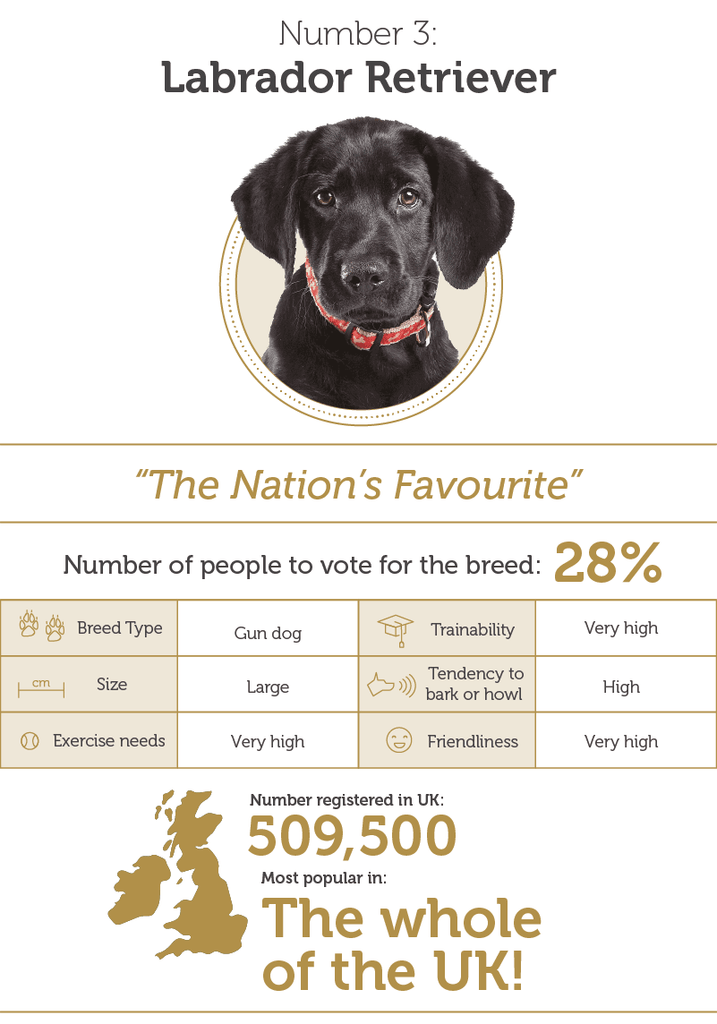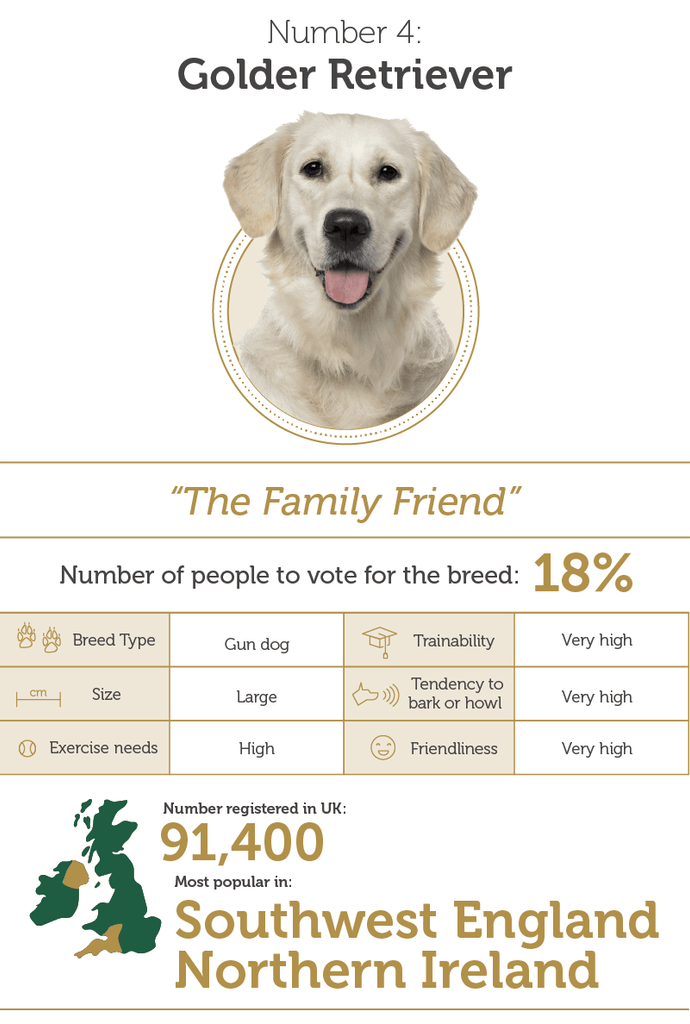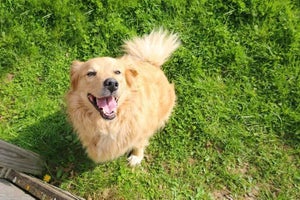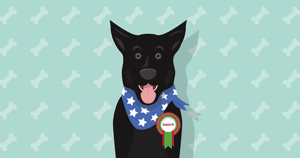
Since humans first brought canines into their homes (or caves), we have been breeding dogs to fulfil a whole range of pet duties; from guarding property and herding farm animals, to hunting and retrieving. Dogs like the Dalmatian are bred to be groomed easily so they require little maintenance, while the Whippet, known primarily for its speed, has been bred to be especially affectionate and makes for a wonderful family pet. But which dog breed wins the prize of the UK’s most intelligent? Intelligence in a dog corresponds to those breeds which best exhibit decision making, concentration and can be trained to understand and perform a wide range of commands.
Why are some dogs more intelligent than others?
The high intelligence of man’s best friend is due to thousands of years spent training them to do complex and careful tasks to help us hunt, fish and farm. This not only requires a range of skills, from tracking scents and following subtle human signals, but a long attention span. A herding dog that can follow all the commands in the world is no use if he or she loses interest and runs off at the first distraction. From conditioning Siberian Huskies to run long distances for days on end to training Irish Setters to fetch ducks, there are a number of signs which all point to an intelligent dog; and the more signs they show, the more intelligent we believe them to be.
What are the common signs of intelligence?
Easy to train
The more commands your dog can understand and the faster he or she learns to associate a word or action with a specific response, the more intelligent they are. Other breeds require more patience and repetition before your furry friend masters a new skill. Remember, just because your dog is intelligent, it doesn’t mean they will willingly learn new tricks without a reason – say, like a treat or a belly rub. They’re clever like that!
Long-term concentration
Dogs that get distracted easily or constantly want to run off and chase passing animals can be challenging to teach complex skills. However, as most intelligent dog breeds were trained to do a lot of labour day-in and day-out, it can be easy to confuse a dog that wants to run off some energy with one that cannot concentrate for a long period of time.
Talkative
Nowadays, we tend not to want our pet pup to bark too often. It can be embarrassing if they do it in public and irritating if they do it in the house or the car. But a chatty dog is actually a sign their breed was traditionally taught to work as a guard dog or herding animals.
High energy
As we mentioned above, lots of energy can be a key indicator of intelligence. Canines that need several hours of running every day are the breeds most likely to have been trained to run along with humans as we carried out daily farming tasks or hunted for some dinner.
Friendliness
One of the most endearing features of any dog is how friendly and loyal they are, especially to their owners. However, this desire to please us and be around us often translates into intelligence. The breeds that are friendliest with their owners, families, children and even strangers are also often those most adept to being trained because of their desire to please their human companions and to read our behavioural cues and facial expressions.
The most intelligent breeds
Now that you know the signs, which of the UK’s dog breeds are the cleverest? While we can identify the key indicators in certain breeds, every dog is unique and shows different levels of every personality trait. So, instead of trying to guess which breed is the most intelligent, Animal Friends Pet Insurance asked 2,000 UK residents which types of dog they believe are the smartest.

Border Collies win the prize as the UK’s smartest dog breed. While dog experts say the average dog can learn about 165 words, Border Collies have been known to learn anything from 250 to a whopping 1,000 words! This intelligence drives from their history as excellent herders. Working in the fields for long hours every day meant they developed an exceptionally close bond with humans. Between their tendency for hard work, high energy and desire to please people, they have developed a special attention span and are capable of carrying out highly complex tasks. After all, there is a reason why Border Collies are the breed we most often see dancing on Britain’s Got Talent. Their pastoral tradition is why they are still generally found around rural and farming regions of the UK, with the most common Border Collie owners being in Wales, Scotland and the Southwest. Of course, with high intelligence comes high responsibility for owners. Like many of the breeds on this list, dogs that are very friendly and highly energetic demand a lot of time. Border Collies are incredibly playful and need frequent physical and mental stimulation to stay happy. Hiding toys and devising clever puzzles is a great way for them to burn off energy and use their brains at the same time, while ignoring them will see them make their own entertainment – often by scratching furniture or digging up the garden. They also need a large house or open space to be able to run off all that energy. Border Collies are great outdoor dogs and can tolerate all weathers, and, with a bit of training, nor will they run off – so can accompany you wherever you go – which is a good thing too, as they get very anxious when left alone. Border Collies are so often found in rural areas because they can be difficult for first-time owners and those that live in built-up urban areas where there is not enough room to run free.

Just nipping second spot in the survey’s most intelligent dog breeds is the German Shepherd. Another working dog that learned its craft by herding and guarding, German Shepherds have since mastered more modern and highly skilled tasks, from using their incredible sense of smell to find trapped and buried people in search and rescue or undesirable substances at airports, to helping the police and military take down criminals and using their faultless obedience to assist the handicapped and the elderly. Above all else, the German Shepherd is probably the most loyal dog breed. They will rarely use their size and strength against another dog, though they tend to prefer the company of people instead of other canines. At worst, they are indifferent to strangers but are frequently friendly. However, they almost always become extremely attached to their primary caregiver and will often pine for their attention and affection. They are also great dogs around children and will actively take on the role of protector and friend. German Shepherds are another breed that are remarkably easy to train and, as evidenced by the sheer diversity of roles they still perform for us, are capable of learning a high number of commands very quickly. They also prefer to stay with the people they know, so are one of the least likely breeds on this list to run off after something which might distract them. However, they are also probably the most energy intensive on this list, too. German Shepherds need frequent long walks. If you live in a city or built-up urban area, start planning out a route and get ready to go out for at least a couple of hours each time.

Despite the rise in popularity of the French bulldog in Wales, London and the North West, the Labrador remains the UK’s number one dog – a spot it has occupied for many years now. Over half a million are registered pets around the nation and with good reason: they are loyal, devoted, deeply people-orientated and love to please. Labradors are another extremely capable breed. Originally bred in Newfoundland, Canada to help fishermen catch fish and haul in their nets, they are not only highly intelligent, but strong and agile, too. Their love of people means they make great carers and have for a long time been the number one breed to be trained to assist the handicapped and the elderly. Once upon a time, after discovering the complex tasks the Newfoundland Labradors were capable of, we brought the breed back to England and trained them as gun dogs. However, while some still harbour lots of energy, it can be 50-50 whether or not you adopt a Labrador that wants to go out running all day, or one that simply prefers to lie next to you on the sofa and have their belly rubbed. Either way, you can expect to be buying a lot of toys to keep their mind and body busy. You will also need a large garden or natural area for them to burn off energy when they feel the need (this is one of the reasons the UK is seeing a rise in smaller dogs, like the cocker spaniel and the pug, in built-up areas). Labradors love love love to eat, so as a pet owner, you will need to be more strict than usual about keeping your four-legged friend on a healthy diet with food that is suitable to their breed, size and age (find suitable and healthy food for your dog here). Labradors are especially prone to weight gain and are one of the most common breeds to become obese; which is compounded further if they do not get enough exercise.

Another working gun dog turned family pet, the golden retriever is another enormously trainable breed capable of learning a huge array of commands, of understanding subtle movements and gestures, and their years as working dogs has seen them develop highly energetic and agile bodies to be able to run, play and perform intelligent skills for hours on end. The one thing they are not is a guard dog! Golden Retrievers, much like Labradors, are so friendly, welcoming and tolerable, that any trespassing thieves or unwanted visitors are more likely to be taken by the hand and given a tour of the house rather than being scared away. Of course, this is because they are one of the most loyal, loving and highly-tolerant dog breeds around, meaning they make outstandingly trustworthy family pets. The reason for this demeanour is simply: they are pack animals and only ever want to be with their family (so don’t leave them alone for long!) and are often described as perpetual puppies that never grow up. While this is endearing, they are big and strong, too, so if you do have kids in the house, the occasional bump might happen when your oversized puppy gets excited (which will be a lot of the time). Like the Labrador, they need a large space to run around in, care and personal attention, and they like to eat a lot. Restrict their food to regular meal times and you can even improve their diet with grain-free food if they show signs of allergies.

Anyone who has ever owned an English Springer Spaniel can tell you just how accurate the breed name represents their behaviour: they love to bounce around all over the place! They were bred for two reasons: to listen and learn from their human masters; and to hunt and retrieve. While we have mostly stopped doing the latter, no one told the English Springer Spaniel, and if they see an opportunity to chase or retrieve something, you can bet they’ll be off after it. For this reason, owners should make sure they secure their home with well-built, high fences. English Springers will jump high and dig deep if it means running after something. Like the other dog breeds on this list, they are enormously energetic and require more than two hours of exercise per day at least. They tend to get on very well with almost anyone and you may often find your dog will run off after their ball, catch it, then take it to a complete stranger so they can join in on the fun. That being said, they will always recognise those closest to them and remain loyal to them. While they’re not quite as natural with children as Labradors and Golden Retrievers, most English Springer Spaniels raised around children from puppyhood will be very good with kids. Again, English Springer Spaniels need mental stimulation as well as physical stimulation, and they love to use their nose to sniff out toys and treats. If it’s late and a bit cold and wet outside, try hiding toys around the house for them to find: it will keep them entertained and tire them out…eventually. They have loving, friendly natures, will watch you closely to learn new skills and behaviours to please you, and are often in want of a cuddle. As such, they make great therapy dogs, too. Just don’t keep them cooped up for too long or they’ll let you know how desperate they are to do some running.
Honourable Mentions
While the 5 breeds above are the most intelligent dog types as voted for by the UK public, there are many other highly trainable, loyal and intelligent canines. Here are just some of the best of the rest:
Irish Setter
Like the other gun dogs listed above, Irish Setters are beautiful breeds who are exceptionally loyal and loving, highly intelligent and extremely playful. They hate being left alone and are especially prone to separation anxiety, so only adopt this breed if you can commit to being with them or making arrangements for him or her to always be in the company of someone they love to be around. They also have a tendency to run off chasing birds, especially ducks, but they’re mostly gentle pets who just want to enjoy a good play and a cuddle.
Jack Russell Terrier
Jack Russell Terriers are another of the nation’s favourite breeds (approximately 376,300 are registered in the UK) and are found consistently in the top 5 popular breeds throughout the country. They are highly intelligent. The problem is that they know it—oh boy, do they know it! These efficient hunting dogs were bred to chase down prey no matter the cost, which means relentlessly chewing, digging and jumping until they have obtained their prize; even if there is a sofa or a garden gate in the way. If they can’t reach it themselves, then they’ll bark until you do instead. Jack Russell Terriers are master escape artists, helped by their small size. In effect, the human race has bred the canine equivalent of Houdini—if Houdini was noisy and had a short attention span. They’re very energetic, easy to groom and, of course, incredibly friendly with families, strangers, children and even other dogs. Just prepare to develop a lot of patience before you begin any training.
Shetland Sheepdog
Much like Border Collies, Shetland Sheepdogs are intelligent and trainable dogs with a lot of energy and devotion to their humans. They are especially responsive to commands and so capable of performing complex skills. They don’t tend to wander off and can be less intense than Border Collies, meaning they are sometimes a little stressful for owners who worry about their dog running away or getting too excited when a visitor comes. That being said, they are still very playful and friendly with people and other dogs of all ages. Like other pastoral dogs, they were bred for a hard day’s work, so be ready to give them a lot of exercise.
English Cocker Spaniel
English Cocker Spaniels are the fifth most popular breed throughout the whole country (224,400 registered as pets) because they have such a wonderful demeanour. They’re extraordinarily playful and friendly without being aggressive, and their small size means you don’t have to worry about them accidentally running into someone or knocking things over. English Cocker Spaniels are very intelligent and can be taught a number of skills and tricks, but require patience, as their puppy-like demeanour means they often get distracted if they think you or someone nearby is about to play with them. They are highly adaptable to living in apartments and excellent for first-time owners. If you make a mistake or maybe get a little too cross with your canine friend, try not to worry – the English Cocker Spaniel will forgive you quickly.
Border Terrier
The Border Terrier is one of the UK’s most popular dogs and is most often adopted in Scotland, the rural North of England, the Midlands, and the Southwest. Like Jack Russells, Border Terriers are incredibly intelligent, but often too interested in doing their own thing to want to sit still for long. However, they adopt to urban living a little easier and are relatively quiet, provided you don’t leave them alone or let them start chewing the furniture. They’re very people-orientated, family-friendly and love to play, but are not especially dog-friendly. Generally, they are easy to maintain and keep healthy, provided you watch their diet as they have a tendency to gain weight quickly.
Regions with high populations of intelligent dogs
Where are they?
It is no coincidence that all the dogs to be voted as the UK’s smartest breeds are medium-to-large-sized working dogs. After all, these are the types bred to be attentive to commands, loyal to their owners and to be out in the fields (or harbours) for hours on end without getting distracted. And while those of us that live in built-up towns, cities and other urban areas have adopted to life where technology assists our every need, in rural areas, these dog breeds continue to fulfil their traditional roles as helpers and workers. Moreover, keeping a highly intelligent, energetic and sociable pet cooped up in a city apartment all day on its own is a recipe for disaster. Consequently, while smaller, milder dog breeds are more popular in densely populated places, the countryside continues to be dominated by larger, working dog breeds. So, while Labradors and Golden Retrievers, known family-friendly pets, continue to be popular in just about every region of the UK (the latter lesser so simply because the breed has longer hair that is more likely to shed regularly), the other breeds are most prevalent in the countryside. Border Collies probably illustrate this best. In Scotland, Border Collies occupy the number 2 and 3 spots in the top 5 popular breeds (after the Labrador, of course) in every region until crossing the border and reaching the more urban Newcastle. Even then, the Border Collie is in the top 5 consistently until reaching cities like Sheffield, Swindon or London. Like Scotland, Border Collies are hugely popular in Northern Ireland and the Southwest of England, though Llandrindod Wells in Wales is the only region of the UK where they reach the coveted number one spot. The English Springer Spaniel, for example, appears in the top 5 breeds in every region in the UK, including Northern Ireland, Wales and Scotland, except in the South East (where it is still in the top 10) and London (where it is outside the top 10). The German Shepherd seems to be the only exception to the rule. While they consistently appear in the top 10 popular breeds in most regions of the UK, not only are they unusually popular in the Greater London Area, but they also appear to be far less popular in Wales than anywhere else.
Which specific places have the highest populations of smart dogs?
While there is a fairly even spread of intelligent dog breeds across the more pastoral parts of the country, we wanted to know which specific regions in the UK can be considered the most intelligent-dog-breed-friendly. Perhaps unsurprisingly, the areas of the country with the highest number of registered intelligent dogs are those which balance population density with easy access to large rural spaces.

Conclusion
Clever dogs are hugely loyal, affectionate and caring and almost everything they do is in the interest of pleasing you and your family. While this truly makes them “man’s best friend”, it is also a massive responsibility for pet owners. Intelligent dogs, by nature of their breeding, are also very energetic, dislike being left alone for long periods, and, because they are used to burning off so much energy every day, are prone to weight gain. Thus, you should only consider getting a smart dog if you can devote sufficient time and attention to them, won’t be bothered by his or her constant desire to play and explore, and can resist those puppy dog eyes to ensure they follow a strict and regular diet. Of course, just because other breeds don’t make the list for the nation’s cleverest dogs, it doesn’t mean they don’t make great pets. In fact, dogs deemed “less intelligent” are often much easier to care for as they don’t demand so much of your time and attention, nor demand as much exercise, and make very trainable and affectionate pets. If you can give them the space they need to burn off their energy and the mental stimulation to keep them from becoming bored, the UK’s smartest dog breeds can also be the nation’s closest companions, as evidenced by how popular these breeds have already become.
https://www.thekennelclub.org.uk/
http://www.bbc.com/news/uk-england-27690167

Related Articles








